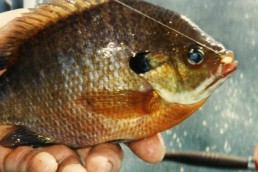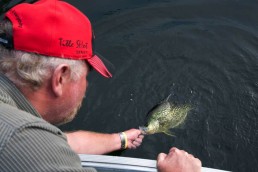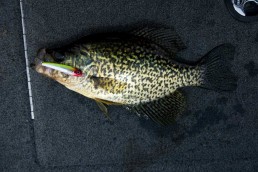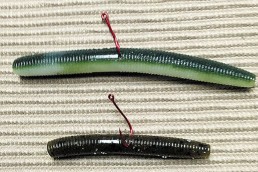Grubs are Deadly for Panfish all Year Long
SHARE THIS POST
Bluegills, crappies and perch are “suckers” for grubs throughout the spring and summer. I have taken many panfish on grubs in the summer out in open water or buried in the weeds. Sometimes grubs are effective when fished with the same ice jigs used in winter months like now in January, but most times, a 1/64- or 1/32-ounce plain jig and grub does the trick. When faced with finicky biters or after-summer cold fronts, a plain number 8 or 10 Eagle Claw hook and grub can work like magic.
Even Lake Michigan perch fishermen are finding out that grubs can be deadly for these tasty panfish when the standard offerings like minnows or crawfish are striking out. But grubs have an appeal to panfish throughout year, and their use can give you confidence.
Natural baits
Syrphid fly larvae, also called “rat-tailed maggots” or “mousies,” are productive baits. These larvae are raised commercially and can be found in most bait and tackle shops or can be collected on your own. The larvae of the syrphid fly is found in aquatic habitats rich in organic matter. They can often be found near sewer outlets in streams or rivers. Mousies are also associated with liquid manure pits found around confined livestock and poultry feeding operations.
Another group of insect larvae often used for baits are gall-forming insects. These larvae cause an abnormal growth or enlargement of the plant where they feed. The larvae is found in the center of this protective gall. One gall-maker is found in common wild golden rod stems, and can be a very deadly bait at times. The larvae of the hickory nut weevil is a white grub, about 1/4 inch long that can be found in the fall as soon as the nuts begin to fall. These can be collected and stored in the refrigerator in a container filled with sawdust or wood shavings until needed.
A favorite bait is the European corn borer. The late-summer generation spends the winter as full-grown larvae in the corn stalk. The holes along the stalk are a giveaway to the presence of these larvae. Once collected, they also can be stored in sawdust and kept refrigerated for later use.
Are you enjoying this post?
You can be among the first to get the latest info on where to go, what to use and how to use it!
Acorn grubs are one of the easiest baits to collect and prepare. Just pick the first acorns off the ground that have fallen from the tree and place them in a wide-bottomed metal container on top of about 2 inches of damp soil. Put the container in the sun for about a week and by then the grubs will crawl into the soil where you can collect them easily.
Probably the most popular grub of all is the waxworm or bee moth. These can be raised on your own with some hassle, but they are the most available grub throughout the summer months at most bait and tackle shops. When purchasing these grubs, buying them in “bulk” containers of 250 or more can provide a considerable savings. The plump, pale yellow grubs do require refrigeration, and must be sorted through every two or three days to remove any dead ones. Waxworms are hardy baits, but even “fresher” dead ones have fish appeal at times—these are grubs that Lake Michigan perch fishermen have discovered to be effective during the warm-water months. According to some sources, they are also effective for channel cats when they’re “globbed” onto a larger hook.
Artificial grubs
Plastic imitations of insects are not new to the fishing scene. For instance, plastic imitations of crickets and grasshoppers have been around for years and can take some nice panfish when fished at the right times. What are new are the plastic or artificial grubs that have been available for the last several years. More than just a “look-alike” imitation, the artificial grubs have scent appeal. Developed to catch more than just the fisherman, these baits are the result of many thousands of dollars of research put forth by the manufacturers.
Berkley of Spirit Lake, Iowa is one company that has spent the money for research. Several years ago they came out with their PowerBaits that are specially formulated with smell and taste enhancers that disperse in water to broaden the strike zone. Gulp Alive has products that contain even more potent attractors. Both PowerBaits and the Gulp Alive attractants and scented baits are non-perishable and require no refrigeration, making them easy to carry in a tackle bag or box. They are available in many shapes, sizes and colors for all conditions and seasons.
MWO
SHARE THIS POST
Did you enjoy this post?
You can be among the first to get the latest info on where to go, what to use and how to use it!
Bill Takacs
Bill Takacs of Hammond, Ind., has been writing for MidWest Outdoors regularly since 1975, and has been published in several state, regional and national publications. He fishes for virtually every freshwater fish from panfish to muskies, with the exceptions of sturgeon and alligator gar.



